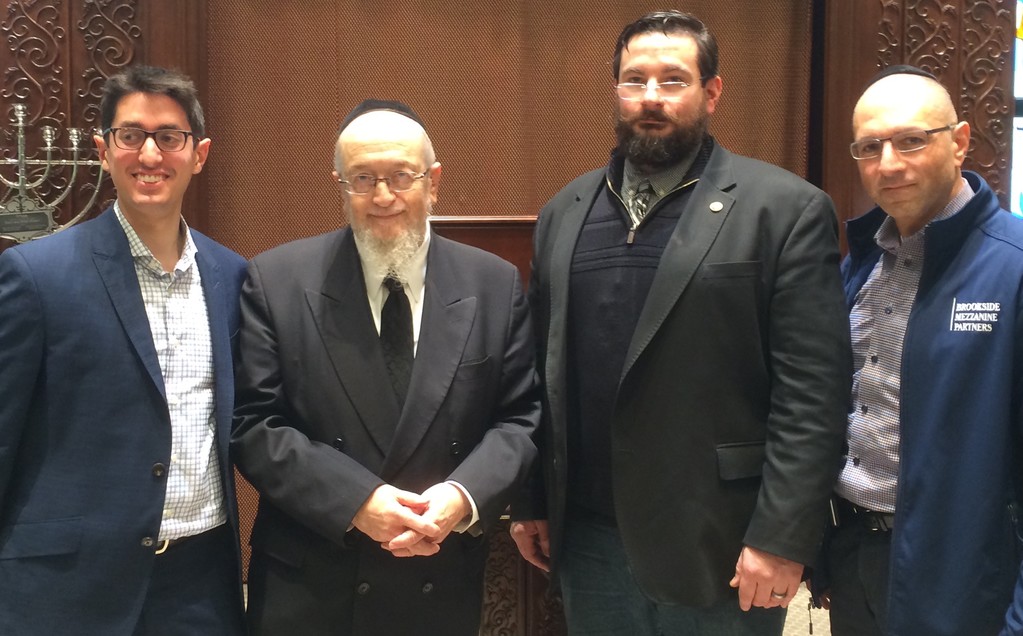Facing ‘active shooter,’ failure to act spells doom, shul crowd told
A key to surviving an active shooter event is “situational awareness,” a security consultant told about 150 Five Towners on Sunday morning.
The speaker, retired NYPD Detective Chris Zaberto, emphasized that victims have only three options once shooting starts: “Run, Hide or Fight.”
“A fourth option, if you choose not to do any of the three, is die,” he told his audience at Kehillas Bais Yehudah Tzvi in Cedarhurst.
Zaberto, chief operating officer of the Ten91 security group, said escaping danger by running is the preferred option; hiding, “barricaded in a room away from the visual line of the shooter” or behind whatever obstacle is available, is next best.
When fleeing or hiding, strongly encourage others — who may be confused or frozen by fear — to follow you, but don’t let their hesitation delay your movement, he said.
Fight only as a last resort and only when your life is in imminent danger, he cautioned, but once a decision is made to fight, total commitment to the fight is required and it’s an action that’s best taken as a group. Act with physical aggression and throw things at the active shooter in a bid to incapacitate him — for instance, spray the shooter’s eyes with the contents of a fire-extinguisher, or hit the shooter with the device. “Utilize anything you have to try to surprise and disorient the shooter,” he said.
Zaberto said that when emergency responders arrive, their objective will be to neutralize the shooter — which means that the evacuation of survivors and caring for the wounded will wait; they may even step on the casualties during their assault. Additionally, since responders may not yet have identified the shooter, they may consider everyone as a possible suspect, and so it’s important to fully cooperate with every police order and to keep one’s hands in view at all times, he said.
Zaberto said there is no single “profile” of an active shooter.
“Mental illness, political agendas, personal vendettas — it’s very hard to say,” he said, citing statistics that in the United States, between 2000 and 2012, 98 percent of active shooters were lone invidividuals and not teams; 96 percent were male; in 78 percent of cases there was a connection between the shooter and his victims; 29 percent of incidents occurred in schools and 55 percent in a workplace or other commercial location.
While statistics cited by Zaberto suggested that only 3 percent of active shooter incidents in the United States occurred in houses of workship, the event’s organizer, Dovid Gerber, told The Jewish Star that globally, Jewish institutions make up 48 percent of institutions targeted by a broad range of terrorist actions.
“We’re looking at the global picture here,” said Gerber, whose Woodmere-based EagleShield consultancy is encouraging Five Towns-area institutions to be more focused on upgrading their security.
Some institutions have accepted federal grants to harden their physical plants, install security cameras and hire guards, but “on a private level, they’re not doing much,” Gerber said.
“Everyone wants to say it doesn’t happen here, but we can see that it can happen anywhere,” he continued. “People forget 9/11 — 2,000 people were killed.”
“Situational awareness” — which Gerber agreed is of paramount importance — includes such basics as knowing the exact address, or at least the cross streets, of where you are, so you can quickly inform 911 operators, Zaberto said.
“Be vigilent in your surroundings. Situational awareness is too often put on the back burner. We’re not thinking about where we are.”
“Have an escape plan,” he continued. “What I like to do when I enter a facility, and I did it when I walked in here, I look to see where the exit doors are. It’s a very benign task, but it’s something we need to start to do routinely. It is unfortunate, but it will save your life one day.
Precautions that can be taken before a crisis include “hardening” your location to keep unwanted people out, Zaberto said.

 51.0°,
Light Rain
51.0°,
Light Rain 




